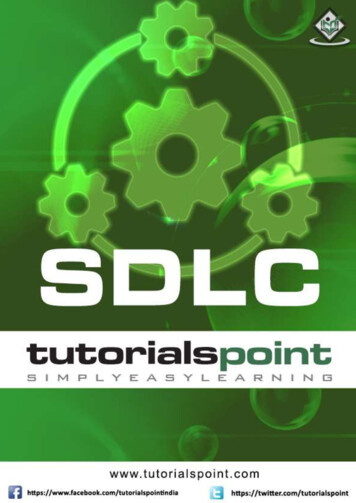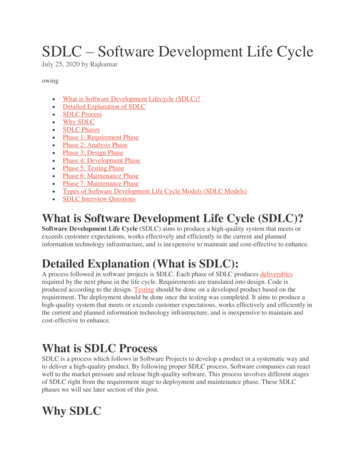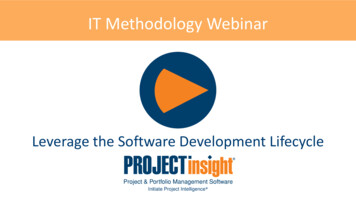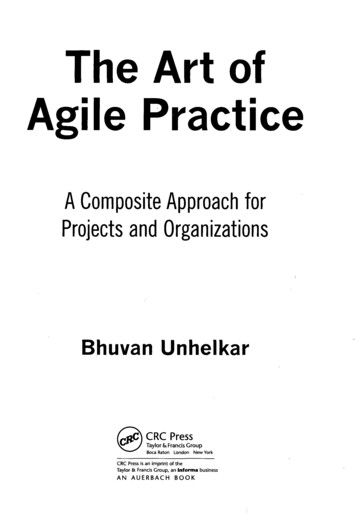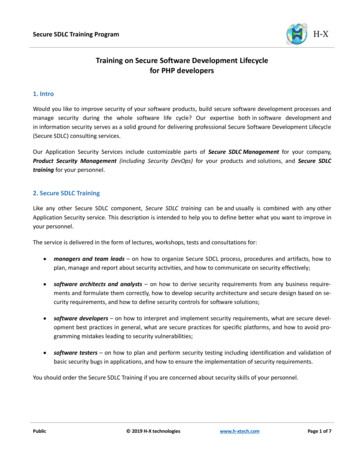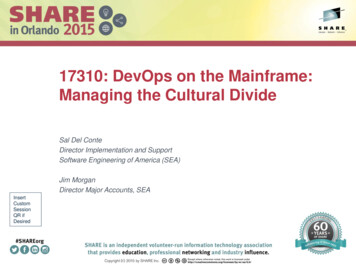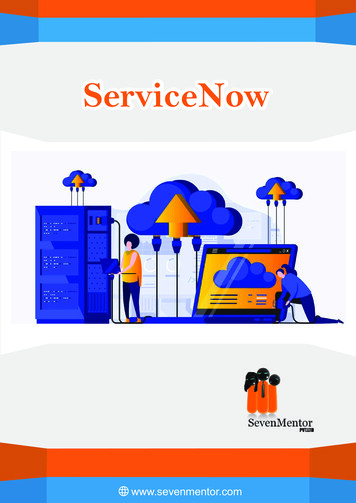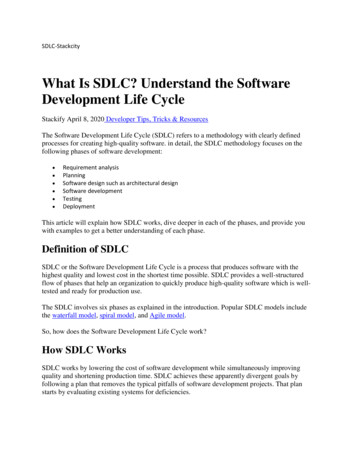
Transcription
SDLC-StackcityWhat Is SDLC? Understand the SoftwareDevelopment Life CycleStackify April 8, 2020 Developer Tips, Tricks & ResourcesThe Software Development Life Cycle (SDLC) refers to a methodology with clearly definedprocesses for creating high-quality software. in detail, the SDLC methodology focuses on thefollowing phases of software development: Requirement analysisPlanningSoftware design such as architectural designSoftware developmentTestingDeploymentThis article will explain how SDLC works, dive deeper in each of the phases, and provide youwith examples to get a better understanding of each phase.Definition of SDLCSDLC or the Software Development Life Cycle is a process that produces software with thehighest quality and lowest cost in the shortest time possible. SDLC provides a well-structuredflow of phases that help an organization to quickly produce high-quality software which is welltested and ready for production use.The SDLC involves six phases as explained in the introduction. Popular SDLC models includethe waterfall model, spiral model, and Agile model.So, how does the Software Development Life Cycle work?How SDLC WorksSDLC works by lowering the cost of software development while simultaneously improvingquality and shortening production time. SDLC achieves these apparently divergent goals byfollowing a plan that removes the typical pitfalls of software development projects. That planstarts by evaluating existing systems for deficiencies.
Next, it defines the requirements of the new system. It then creates the software through thestages of analysis, planning, design, development, testing, and deployment. By anticipatingcostly mistakes like failing to ask the end-user or client for feedback, SLDC can eliminateredundant rework and after-the-fact fixes.It’s also important to know that there is a strong focus on the testing phase. As the SDLC is arepetitive methodology, you have to ensure code quality at every cycle. Many organizations tendto spend few efforts on testing while a stronger focus on testing can save them a lot of rework,time, and money. Be smart and write the right types of tests.Next, let’s explore the different stages of the Software Development Life Cycle.
Stages and Best Practices of SDLCFollowing the best practices and/or stages of SDLC ensures the process works in a smooth,efficient, and productive way.1. Identify the Current Problems“What are the current problems?” This stage of the SDLC means getting input from allstakeholders, including customers, salespeople, industry experts, and programmers. Learn thestrengths and weaknesses of the current system with improvement as the goal.2. Plan“What do we want?” In this stage of the SDLC, the team determines the cost and resourcesrequired for implementing the analyzed requirements. It also details the risks involved andprovides sub-plans for softening those risks.In other words, the team should determine the feasibility of the project and how they canimplement the project successfully with the lowest risk in mind.3. Design“How will we get what we want?” This phase of the SDLC starts by turning the softwarespecifications into a design plan called the Design Specification. All stakeholders then reviewthis plan and offer feedback and suggestions. It’s crucial to have a plan for collecting andincorporating stakeholder input into this document. Failure at this stage will almost certainlyresult in cost overruns at best and the total collapse of the project at worst.4. Build“Let’s create what we want.”At this stage, the actual development starts. It’s important that every developer sticks to theagreed blueprint. Also, make sure you have proper guidelines in place about the code style andpractices.For example, define a nomenclature for files or define a variable naming style such ascamelCase. This will help your team to produce organized and consistent code that is easier tounderstand but also to test during the next phase.5. Code Test“Did we get what we want?” In this stage, we test for defects and deficiencies. We fix thoseissues until the product meets the original specifications.In short, we want to verify if the code meets the defined requirements.
6. Software Deployment“Let’s start using what we got.”At this stage, the goal is to deploy the software to the production environment so users can startusing the product. However, many organizations choose to move the product through differentdeployment environments such as a testing or staging environment.This allows any stakeholders to safely play with the product before releasing it to the market.Besides, this allows any final mistakes to be caught before releasing the product.Extra: Software Maintenance“Let’s get this closer to what we want.” The plan almost never turns out perfect when it meetsreality. Further, as conditions in the real world change, we need to update and advance thesoftware to match.The DevOps movement has changed the SDLC in some ways. Developers are now responsiblefor more and more steps of the entire development process. We also see the value of shifting left.When development and Ops teams use the same toolset to track performance and pin downdefects from inception to the retirement of an application, this provides a common language andfaster handoffs between teams.Application performance monitoring (APM) tools can be used in a development, QA, andproduction environment. This keeps everyone using the same toolset across the entiredevelopment lifecycle.Read More: 3 Reasons Why APM Usage is Shifting Left to Development & QAExamples of SDLC in ActionThe most common SDLC examples or SDLC models are listed below. Waterfall Model. This SDLC model is the oldest and most straightforward. With thismethodology, we finish one phase and then start the next. Each phase has its own mini-plan andeach phase “waterfalls” into the next. The biggest drawback of this model is that small detailsleft incomplete can hold up the entire process.Agile Model. The Agile SDLC model separates the product into cycles and delivers a workingproduct very quickly. This methodology produces a succession of releases. Testing of eachrelease feeds back info that’s incorporated into the next version. According to Robert Half, thedrawback of this model is that the heavy emphasis on customer interaction can lead the projectin the wrong direction in some cases.Iterative Model. This SDLC model emphasizes repetition. Developers create a version veryquickly and for relatively little cost, then test and improve it through rapid and successiveversions. One big disadvantage here is that it can eat up resources fast if left unchecked.
V-Shaped Model. An extension of the waterfall model, this SDLC methodology tests at eachstage of development. As with waterfall, this process can run into roadblocks.Big Bang Model. This high-risk SDLC model throws most of its resources at development andworks best for small projects. It lacks the thorough requirements definition stage of the othermethods.Spiral Model. The most flexible of the SDLC models, the spiral model is similar to the iterativemodel in its emphasis on repetition. The spiral model goes through the planning, design, buildand test phases over and over, with gradual improvements at each pass.Benefits of SDLCSDLC done right can allow the highest level of management control and documentation.Developers understand what they should build and why. All parties agree on the goal upfront andsee a clear plan for arriving at that goal. Everyone understands the costs and resources required.Several pitfalls can turn an SDLC implementation into more of a roadblock to development thana tool that helps us. Failure to take into account the needs of customers and all users andstakeholders can result in a poor understanding of the system requirements at the outset. Thebenefits of SDLC only exist if the plan is followed faithfully.Want to improve application quality and monitor application performance at every stage of theSDLC? Try out Stackify’s Retrace tool for free and experience how it can help your organizationat producing higher-quality software.
V-Shaped Model. An extension of the waterfall model, this SDLC methodology tests at each stage of development. As with waterfall, this process can run into roadblocks.



